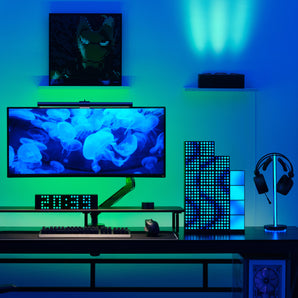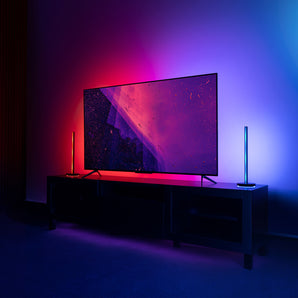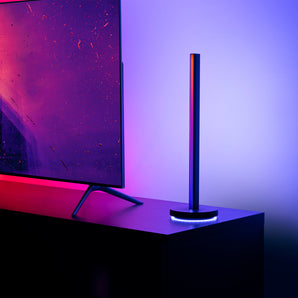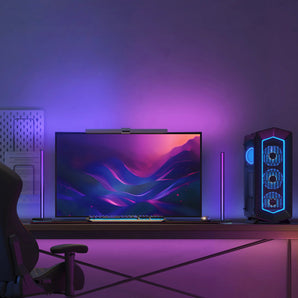Smart lights are a common start point for a smart home, ranging from light bulbs and plugs to light switches and wall panels. And, with so many new alternatives on the market, including low-cost smart LEDs, you might be tempted to fill your entire house with them.
And perhaps you should! There’s a lot of highlights for a whole-home connected smart bulbs setup, including advantages such as automated vacation-mode lighting that makes it appear as if you’re home when you’re not, the fun fad of color-changing bulbs, and the easiness of turning off all the lights your children left on with your voice as you leave for work or go to bed.
Nevertheless, before you load your shopping cart, you need to learn about smart lighting to ensure you’re purchasing the finest lights and switches for your smart home. To that end, here’s a summary of everything you should know before investing.
What is a Smart Bulb
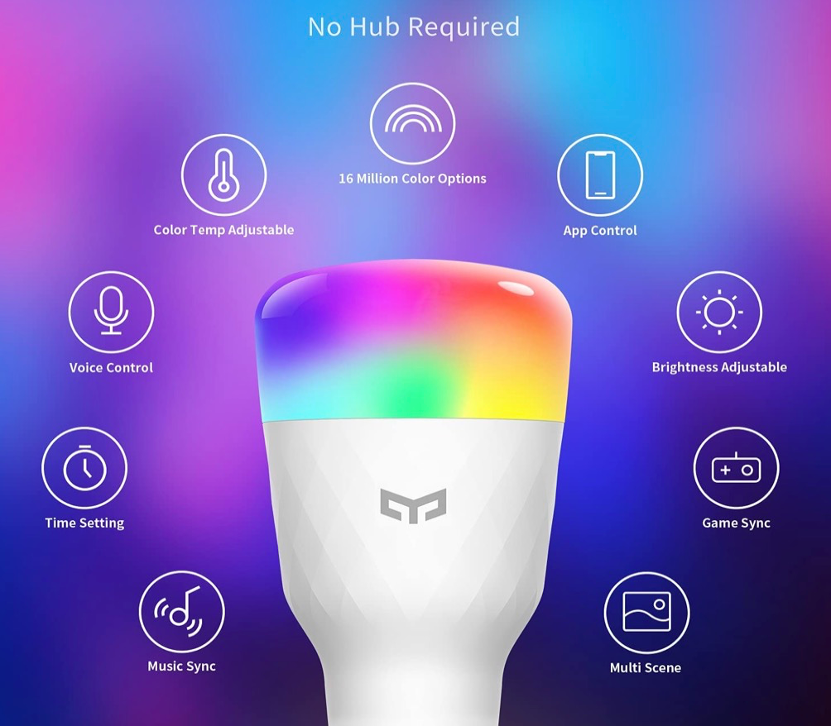
What does smart bulb, a frequently referred term, actually mean? By definition, smart light bulbs are, in short, remotely controllable lighting devices. The difference between normal bulbs and smart bulbs is that smart bulbs enable hands-free control with the help of a remote, a mobile device, or simply your voice.
Further, a smart bulb can be personalized and programmed, offering great convenience and enjoyment for you. When connected to the proper smart switches, smart bulbs can be turned on and off automatically as scheduled. A smart bulb can be activated at a given time of a day, or according to personalized settings, making our life genuinely more efficient and intelligent.
Several Ways to Control a Smart Bulb
With a mobile app
Installing an app on your phone that communicates with your home network to manage your smart light bulbs, switches, outlets, or light fixtures allows you to control the lights in your house from anywhere.
With Bluetooth
Some smart bulbs only support the 2.4 GHz wireless protocol, requiring a local WiFi connection to communicate with the smart bulb app. However, the majority of the smart bulbs include Bluetooth to enable close-range communication between the app and the lights in the event that there is no WiFi signal.
With a smart switch

The smart switch or dimmer is the most comprehensive choice, which entails replacing ordinary light switches with a “smart” version that incorporates wireless technology into the switch itself. The benefit of this technique is that remote and normal manual controls are offered, as well as the ability to monitor the light’s on/off state even when it is turned off at the switch.
With an automation hub
A home automation hub can be used to control the smart bulb wirelessly. Hubs often employ communication protocols such as Bluetooth, Wi-Fi, Z-Wave and ZigBee, which enable the automation hub to be connected to the designated devices (mobile device, tablet and PC) via an app.
Why Should You Choose a Smart Bulb

They can be controlled from anywhere

Smart lights take the concept of “remote control” to another level. As long as your bulbs are connected to your smart device, you can very well monitor your home’s lights from anywhere in the world.
They can be controlled by voice
Smart bulbs let you manage your illumination with simple voice commands. You can use your voice to turn smart lights on and off, dim them, or order them to play music or change colors, simply with your voice. Anything you want, just say it.
They are personalized
There is a broad variety of smart bulbs on the market, so whatever your needs or preferences are, you can discover a device that simplifies your life, reduces your energy footprint, and transforms your entire house into a safe, stress-free, well-lit retreat.
They save you money
Yes, the initial expenses of converting to smart lighting are significantly greater than staying with standard energy-saving bulbs, but over time, you will save dollars on your lighting bills. Even better, more intangible savings are actually your time and effort—no more wriggling out of bed to make sure the kids get to turn off the lights on their height level—you can do it directly from your phone. If you think that you don’t need to spend a lot of money on home comforts, look into more inexpensive smart lighting solutions, there are actually plenty of them on the market.
They can help you sleep better

Another great thing about smart bulbs that we have to talk about is that they are a great helper for you to get a better night’s rest. Your brain is extremely sensitive to light, which has a significant impact on our sleep patterns. When it gets dark, our brain tells us that we’re weary and should get some sleep. When the sun rises and the sky brightens, our brain feels this and tells us it’s time to get active.
Smart lights can help you circumvent your biological clock by imitating lovely, gradual dawn to assist you to get out of bed in the morning. It thus becomes simpler for you to fall asleep when you set your bedroom’s smart lights to a low level and instruct them to face out gradually over half an hour.
They change colors

Image source: Proshop
Smart bulbs know how to delight your mood with the right color. Many smart lights today are music sync and have motion sensors. When you’re watching a movie, playing a game, reading a book, or getting ready for a party, smart lights can change the colors and help you set the perfect mood.
And that isn’t all, smart light that emits blue illumination may lift your spirits, especially during the winter when the cloud cover is thick and sunshine is scarce. Therefore, smart lights are more personal and know your needs better.
They dance to music
I’m not sure how practical music-playing smart lights are, but you can surely enjoy a more relaxing and entertaining vibe with them. For example, Yeelight LED Color Smart Bulb W3(to be launched next month) can be connected to the music by the built-in MIC with sound recognition, or a headphone via audio Y-cable. The smart LED bulbs add stunning color to your music and allow you to enjoy an immersive experience. The panels support Google Home, Alexa, and Xiaomi Smart Speaker. With the help of a cell, app, or Xiao Ai Lite, smart light panels shine whenever you need.
Some can play music
With Bluetooth-activated smart lighting with speakers, you can transform any lamp—indoors or outdoors—into a radio. Connect the smart light bulbs to your device via an app, and stream songs from your phone, ipad, or TV to bring the party everywhere as long as there is a light.
They are durable
A typical incandescent light bulb has a lifespan of 1,000-2,000 hours. In comparison, an LED bulb has a lifespan of 25,000-50,000 hours. Smart LED bulbs are expected to last between 15,000 and 25,000 hours. Depending on how it is used, a single smart bulb might live for years and years.
They are compatible
Image source: reviewed
Does smart bulb function in lamps and other light fittings? Another benefit of smart bulbs is that they are compatible with both multi-fixture lamps and single fixture lamps. They work in every lamp configuration accessible. You may buy your choice of smart bulbs to illuminate your house.
There are several sizes, styles, and combinations to consider when purchasing a smart bulb. A smart bulb can be used for any lamp lighting application(s) in your house. It all depends on what you want to do with the smart bulb and how much you’d like to invest.
Things to Know Before Buying a Smart Bulb
You’ll want to pick a control platform
The first thing to consider before purchasing smart lights is which platform you want to utilize to control them. Most alternatives have control applications, such as the Yeelight app and the Hue app, that allow you to group lights together and set them to turn on and off at certain times.
How much do smart bulbs cost? Yep, less than you think
It wasn’t a long time ago that some folks were spending $30 or even $50 per bulb to get normal, unconnected LED lights installed in their homes. The arithmetic made sense: an average LED will add approximately $1 to your annual energy cost, compared to around $7 for an equivalent incandescent. That implies that a single LED bulb will save you roughly $6 each year over an old-fashioned bulb just like this – and because LEDs are meant to last for decades, investing dozens of dollars for one upfront was a wise long-term investment.
Then, in 2014, increased efficiency regulations and market-moving federal subsidies galvanized the sector into action, resulting in a slew of new lighting alternatives. The increasing competition aided in the reduction of prices, while customer demand encouraged the sector to continue developing.
As a consequence, smart LED light bulbs have improved and become more affordable. And, certainly, recent moves to pull back those efficiency requirements should not change that fact; the lighting business has already ushered us into the LED era, and there’s no indication that it intends to reverse course.
That same buyer’s market applies to smart lights, with outstanding options from Yeelight and Philips Hue available for much less cost per bulb. Meanwhile, a good smart light switch shouldn’t cost you much more than $30. Even sophisticated smart colorful bulbs aren’t that expensive these days, with tried-and-true alternatives from respectable companies available for less than $30 per.
A hub is needed sometimes
To send and receive messages, smart lights employ wireless transmissions, and various bulbs use different ways. Some feature built-in Wi-Fi radios that link directly to your network, allowing you to operate them remotely from anywhere that has internet. Others utilize Bluetooth to connect to your phone when you’re within a close distance such as 50 feet. To manage such bulbs from a distance, you’ll need a Wi-Fi hub to transmit their signals to your network and, from there, to you through the cloud.
Then there’s Zigbee, which may be thought of as a local wireless network for your smart home devices. Zigbee is used by many smart lighting devices to relay data.
Having said that, things are improving. Philips Hue, the most well-known Zigbee brand, and Yeelight, a brand coming on strong, has lately begun incorporating alternative Bluetooth radios into its devices, allowing you to bypass the hub and connect directly with your phone for basic functions. Today, many no-hub-smart-bulb devices, and more emerging, on the market can convert Zigbee smart bulb signals into something that your Wi-Fi router can comprehend.
Take switches and plugs into your considerations
Light bulbs and the platform are essential, but you cannot afford to neglect switches and plugs. Sticking with smart bulbs will provide you with the most economical alternatives while searching for smart lighting. Having said that, you should certainly think about including smart plugs and smart light switches into the mix as well.
In terms of the plug front, there are a plethora of alternatives for around $20 or less that can automate whatever you plug in behind them. When used with a light, you may automate it to turn on and off anytime you want by utilizing voice commands, all while using whatever bulb you choose. Smart plugs are also an excellent choice for alternatives such as ornamental string lights.
Finally, once your smart bulbs are connected to your lamp(s), they may perform a variety of duties. The colors may be adjusted, as well as the color temperature of the lights. The lights will respond to specific apps via tapping, as well as voice-activated systems.





